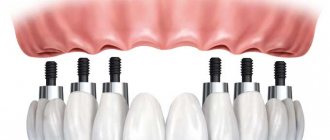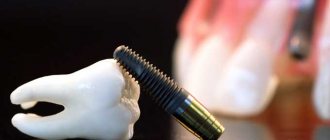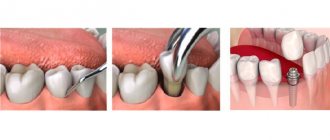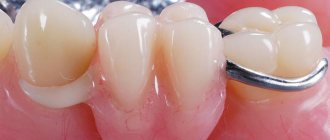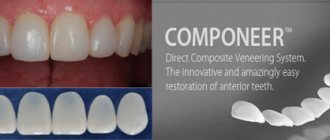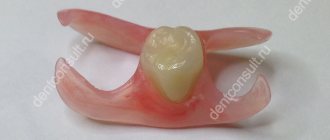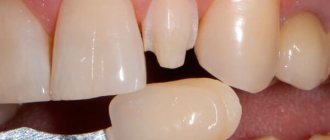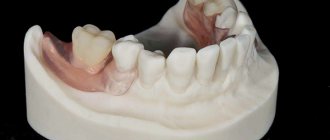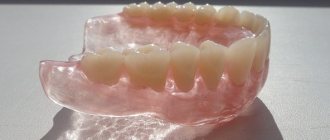What are dental crowns
These are non-removable orthopedic structures that are identical in appearance to a natural tooth and fit onto it like a cap. Installed on heavily damaged units that cannot be sealed.
According to the material they are classified into:
- plastic - temporary structures;
- metal-free - ceramic or zirconium, coated with a thin layer of porcelain mass;
- metal - made of metal alloys, gold or gold-plated;
- metal-ceramic - made of metal coated with ceramics.
Depending on the purpose:
- restorative - used to restore functions and the anatomical shape of a damaged tooth.
- supporting - placed as a support for the bridge.
By type of construction:
- complete - completely replace the destroyed unit;
- equatorial - made of metal, fixed around the tooth in the form of a splint;
- half-crowns - do not overlap the unit of the dental row from the side of the tongue, serve as a support for the bridge;
- telescopic - used for attaching removable dentures, changing the volume and height of the tooth.
- pin - mounted on a pin.
Indications for installation include:
- the coronal part is destroyed by more than 1/2;
- increased abrasion of enamel;
- severe damage caused by pathologies.
If a tooth is missing, the crown replacing it is fixed to adjacent units.
Crown or implant: what to choose
What is better to choose? From the point of view of economy, it is better to choose crowns, the installation price of which is 10-15% lower than the cost of implants. But the choice of prosthetic method is made only by an orthopedic doctor, who assesses the condition of the oral cavity, bone tissue, and also takes into account chronic diseases and the patient’s age.
Note that in the case when it is necessary to install several teeth in a row, it is better to choose an implant. It is also worth doing if the teeth located nearby are alive and do not have caries or fillings.
What is dental implantation
After the implant has healed, a crown is placed on top.
An artificial titanium root is implanted into the jaw bone in place of the removed unit. Implants are installed for single, partial and complete edentia.
Implantation is a surgical operation performed under local or general anesthesia. Therefore, tests, X-rays, and computer modeling are mandatory. If the tooth has been missing for a long time, the doctor needs to drill into the gum to install the rod. However, recently, the implantation of an artificial root increasingly takes place immediately after extraction of the diseased unit.
Types of implants:
- Root - in the form of a cone or cylinder with a thread at the base. Osseointegration occurs most easily when there is sufficient bone; if there is insufficient bone, it is augmented surgically.
- Lamellar - used for narrow jaw bones.
- Lamellar-root - combines the two previous types. Practically not used due to its large size and difficult implantation process.
- Subperiosteal - indicated for thinned bone.
- A mini implant is smaller in size than a traditional one. Designed to stabilize removable dentures.
Dental prosthetics and implantation: cost
At first glance, it seems that traditional dentures are cheaper than implants. But in the long run, they are more economical than removable and fixed dentures. The latter need to be completely changed every few years. You only need to pay for implants once. The only thing you will have to pay for in the future is changing the crown, but it will be required very rarely.
A good example
50,000 rubles - this is how much a high-quality implant costs, on which a crown made of ceramics or metal-ceramics is installed. It will serve the patient for life.
30,000 rubles - this is the price of a bridge installed for a patient with one missing tooth.
Let's count further. 5 or 7 years pass. The bridge has to be installed again. But you will have to restore not just one tooth, but most likely several. It is then that the understanding comes that the savings were imaginary.
Comparing the benefits of crowns and implants
Compared to titanium rods, crowns have significantly fewer advantages. Their advantages include:
- speed of production and installation;
- low cost.
Among the advantages of implants:
- Long service life. Artificial roots are resistant to temperature irritants and withstand chewing loads well. In 90% of cases, with good care, they last throughout the patient’s life.
- There is no need to grind adjacent units.
- The bone of the upper and lower jaw does not atrophy.
- High level of aesthetics.
- There are no restrictions on the consumption of solid foods.
- Easy to care for; traditional oral hygiene is sufficient.
- The solidity of the structure, ensured by the abutment (adapter-mount), prevents food particles from getting under the prosthesis.
Advantages and disadvantages of implantation
An implant is an artificial rod that is implanted into bone tissue. This is actually a new root on which an artificial tooth is formed. It is practically indistinguishable from natural material in appearance and functionality.
Implantation is the most modern method of prosthetics. Using this technique, you can restore one or more teeth, as well as the entire dentition. The patient perceives the implanted teeth as his own. Thus, implantation is a prosthetic technology that allows you to almost completely restore the aesthetics and functionality of teeth.
To insert a dental implant, there is no need to grind down adjacent teeth. Another important advantage is that artificial roots prevent the death of bone tissue. Dental implants have a long lifespan. In more than 90% of patients they persist until the end of life.
The disadvantages of this prosthetic method include:
- Implantation is a surgical operation that is performed under local anesthesia and requires rehabilitation.
- This is an expensive procedure. But in fact, the cost is not much higher than other types of prosthetics.
Implants and crowns: what are the disadvantages?
The disadvantages of single dentures include:
- Significant risk of damage to adjacent healthy teeth.
- Fragility of non-metallic structural elements.
- Possibility of complications:
- if the size is incorrectly selected, they rub and provoke the development of inflammation;
- a small gap remains between the gum and the crown, in which food debris can accumulate, causing an unpleasant odor and destruction of the jaw structures;
- allergic reactions to the material from which a single prosthesis is made are possible;
- development of galvanic syndrome - if there are orthopedic structures made of different metals in the mouth, the patient may experience a metallic taste and headaches;
- risk of gum receding, exposure of the dental neck.
- Short service life compared to implants. The crown is fixed on a pulpless tooth, the destruction of which is a matter of time.
- Consumption of solid foods is contraindicated.
Implants also have disadvantages:
- There is a risk of rejection.
- The procedure for implanting a titanium root is more painful than prosthetics (the disadvantage is eliminated by the use of anesthetic drugs).
- Duration of the method. It takes 4-6 months for the rod to fully engraft.
- Risk of complications:
- damage to the mandibular nerve;
- perforation of the maxillary sinus with small bone volume;
- seam divergence;
- development of inflammation and infection.
- The need for long visits to the dental clinic.
- When installing several implants, to properly distribute the load, a separate orthopedic structure is placed on each one.
Missing teeth: what could be the consequences?
Even the loss of one tooth entails the development of various kinds of complications:
- The position of the teeth in the row is distorted, the bite is disturbed, which can lead to diseases of the temporomandibular joint and the masticatory muscle group.
- The remaining teeth begin to decay faster, as bacterial plaque begins to accumulate in the enlarged interdental spaces, which contributes to this.
- The jaw bone in the area of the missing tooth begins to gradually atrophy, the gums change their relief and sag.
- The function of chewing food is impaired, which leads to digestive problems.
- Articulation is impaired, and various speech defects appear.
- The shape of the face changes - the nasolabial folds deepen, the corners of the mouth droop, the person looks older.
- Psycho-emotional problems appear.
The above complications do not appear immediately after tooth loss, but if the problem of the dentition is not solved in a timely manner, they are inevitable over time.
How to make a choice
Before choosing the type of prosthetics, consultation with a specialist is necessary.
To choose the type of prosthetics - implants or traditional - you need to assess the condition of the oral cavity. The doctor examines the shape of the jaws, the amount and condition of bone tissue, and the location of the mandibular nerve. For this purpose, computed tomography and orthopantomogram are used.
If the patient is inclined towards implantation, it is necessary to undergo a full examination. You should opt for implantation when:
- it is necessary to restore one or more teeth in a row;
- a destroyed tooth is adjacent to healthy teeth, since after removing the nerves under the crowns, they will collapse faster.
When choosing a crown, first of all, the supporting teeth are assessed (the possibility of not having to remove nerves, the quality of canal filling if the tooth is pulpless). It is recommended to install a crown when the supporting teeth have already been filled or damaged.
Dental bridge or implant for front teeth
If you are installing a bridge or implant on a front tooth, then the issue of aesthetics becomes paramount. Any ceramic crowns are perfect here. When restoring teeth in the smile area, a layer of porcelain is usually applied to zirconium crowns, since dentures made from solid zirconium can look a little unnatural. The front teeth are less involved when chewing food, so serious loads bypass them. On the other hand, a conventional bridge will not relieve atrophy of bone tissue and gums - only implants can do this.
pros
If implantation is indicated for a patient, he must understand that, despite the complexity of the procedure, it has a lot of undeniable advantages that no other method of prosthetics can provide.
These include:
- ideal aesthetic content - artificial fragments of the jaw row can hardly be distinguished from natural units;
- speech function does not suffer, which often happens when using a removable denture;
- high stability – the systems are designed for constant use, they are resistant to caries formations, do not hurt and are not susceptible to inflammatory processes;
- comfort during eating - the structures are motionless, do not cover the palatal area, do not require dietary restrictions and do not interfere with the activity of taste buds.
Possible complications and contraindications
Since the manipulation involves the intervention of a surgeon, there are sufficient indications for its implementation, as for any other operation. They are classified according to the following criteria.
Absolute
This:
- age threshold - for patients under 18 years of age, installation of structures is not carried out due to the unformation of the structural content of the tissues;
- diagnosing systemic connective tissue diseases;
- acute mental disorders;
- drug and alcohol addiction;
- osteoporosis in an advanced stage;
- acute form of heart attack;
- chronic renal failure;
- liver dysfunction;
- diabetes in the stage of decompensation.
Relative
Relative contraindications are factors that make installation temporarily impossible until they are eliminated. Once they are eliminated, the ban is lifted.
We are talking about the following situations:
- pregnancy - at all stages;
- breast-feeding;
- severe bruxism – the exception is the patient’s consent to use mouthguards. It is given in writing;
- smoking abuse;
- compensated diabetes mellitus.
Temporary
The procedure will have to be postponed if there are factors that are temporary:
- acute viral and infectious diseases;
- stages of rehabilitation after diagnoses of increased severity;
- radiation therapy.
As you prepare for the operation, these contraindications can be eliminated spontaneously.
Are common
Dental implants are not installed due to general contraindications if:
- there is an individual intolerance to anesthetic drugs that can provoke allergies;
- general somatic diagnoses – cardiovascular failure, respiratory dysfunction;
- the use of drugs that are antidepressants, immunostimulants, cytostatics;
- prolonged stressful state of a person;
- cachexia;
- failure to maintain proper oral hygiene.
Local
Prohibitions of local significance are manifestations of a local nature:
- insufficient volume of bone tissue in the working area and its inadequate quality condition, making artificial augmentation impossible;
- The distance of the tooth from the maxillary and nasal sinuses is too small.
Unfortunately, this group of contraindications is considered irremovable in most cases.
Video: What to choose
Definition
A dental implant is a structure whose base is made of a medical titanium alloy, capable of fully replacing the root part of a lost organ. Its outer part looks as natural as possible, and it cannot be removed.
The device does not require special cleaning after use - except perhaps standard hygiene procedures.
Consists of the following elements:
- pin - is a screw implanted into the deep layers of hard bone tissue;
- abutment – outer segment, serves as a base for installing a crown;
- directly, a crown is an artificial copy of the outer part of a tooth, completely repeating its appearance and relief.
